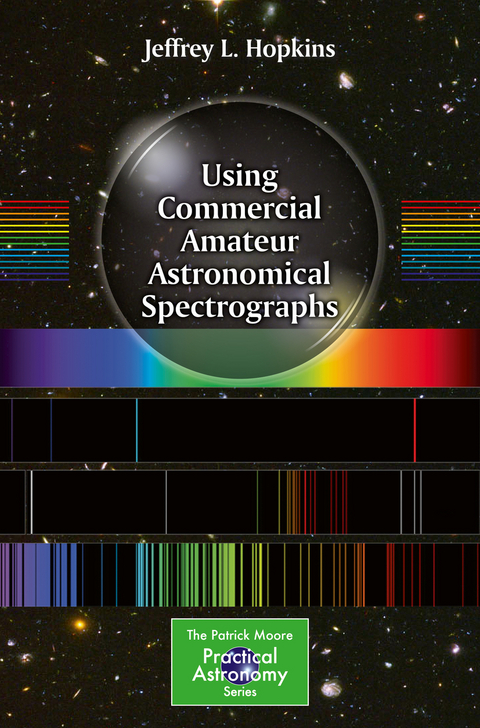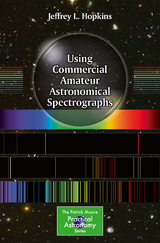Using Commercial Amateur Astronomical Spectrographs
Springer International Publishing (Verlag)
978-3-319-01441-8 (ISBN)
Amateur astronomers interested in learning more about astronomical spectroscopy now have the guide they need. It provides detailed information about how to get started inexpensively with low-resolution spectroscopy, and then how to move on to more advanced high-resolution spectroscopy. Uniquely, the instructions concentrate very much on the practical aspects of using commercially-available spectroscopes, rather than simply explaining how spectroscopes work.
The book includes a clear explanation of the laboratory theory behind astronomical spectrographs, and goes on to extensively cover the practical application of astronomical spectroscopy in detail. Four popular and reasonably-priced commercially available diffraction grating spectrographs are used as examples. The first is a low-resolution transmission diffraction grating, the Star Analyser spectrograph. The second is an inexpensive fiber optic coupled bench spectrograph that can be used to learn more about spectroscopy. The third is a newcomer, the ALPY 600 spectrograph. The fourth spectrograph considered is at the other end of the market both in performance and cost, the high-resolution Lhires III. While considerably more expensive, this is a popular and excellent scientific instrument, that allows more advanced amateur astronomers to produce scientifically valuable data.
With all of these tools in place, the amateur astronomer is well-prepared to forger deeper into the night sky using spectroscopy.
Jeffrey Hopkins was born and raised in upstate New York. The area instilled a wonder of the night sky with its multitude of stars and interesting objects, but most of the time clouds prevented astronomical observing. In 1974, he moved to Arizona, an ideal place for practical astronomy. Even in suburban Phoenix, the night skies are clear most of the time, and in the early 1980s Hopkins discovered astronomical photometry: this is real science that can be done from a backyard! He built his own UBV photon-counting photometer and spent the next 30 years on astronomical photoelectric photometry. In 2006 he was introduced to small telescope spectroscopy and was amazed at what could be done even with a small telescope from a Phoenix backyard. In the Spring of 2012 Hopkins had the honor of having the Minor Planet 187283 assigned to him. He was presented with the 2012 Amateur Achievement Award at the August 2012 meeting of the Astronomical Society of the Pacific. Hopkins's publications include Zen and the Art of Photoelectric Photometry (1990), Workbook for Astronomical Photoelectric Photometry (1990, co-author Dr. Paul Schmidtke), AutoStar CCD Photometry (2007, co-author Gene Lucas), Epsilon Aurigae A Mysterious Star System (2008, co-author Dr. Robert Stencel), and Small Telescope Astronomical Spectroscopy (2012). He has had articles published in Astronomy, and Sky & Telescope magazines, and is the author of over 50 professional papers, including several presented at the Society for Astronomical Sciences Symposiums in Big Bear, California. In January 2011 he presented to the American Astronomical Society meeting in Seattle, Washington.
From the Contents: Part I Introduction to Spectroscopy.- Spectroscopy Theory.- Astronomical Spectroscopy Theory.- Part II Using Amateur Spectrographs.- Equipment.- Taking Spectra.- Low Resolution Spectroscopy with a Star Analyser.- High Resolution with a Lhires III 2400/600 line/mm gratings.- Part III Spectrum Processing Software.- DIY (Excel).- RSpec.- Vspec.
| Erscheint lt. Verlag | 2.12.2013 |
|---|---|
| Reihe/Serie | The Patrick Moore Practical Astronomy Series |
| Zusatzinfo | XXXI, 286 p. 269 illus., 62 illus. in color. |
| Verlagsort | Cham |
| Sprache | englisch |
| Maße | 155 x 235 mm |
| Gewicht | 553 g |
| Themenwelt | Naturwissenschaften ► Chemie ► Analytische Chemie |
| Naturwissenschaften ► Physik / Astronomie ► Astronomie / Astrophysik | |
| Schlagworte | Amateur Astronomers Spectrography • Amateur Astronomers Spectroscopy • RSpec Software Guide • Using Astronomical Spectrographs • Using Astronomical Spectroscopes • Using Lhires III Spectrograph • Using Star Analyser • VSpec Software Guide |
| ISBN-10 | 3-319-01441-2 / 3319014412 |
| ISBN-13 | 978-3-319-01441-8 / 9783319014418 |
| Zustand | Neuware |
| Haben Sie eine Frage zum Produkt? |
aus dem Bereich




